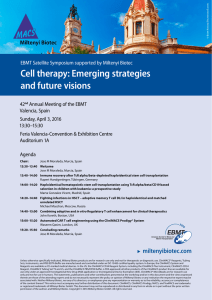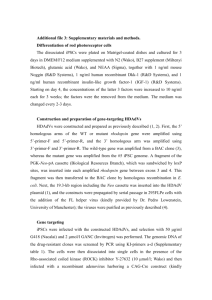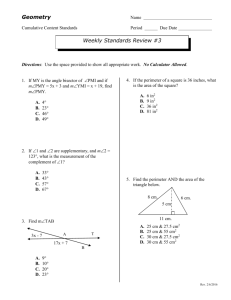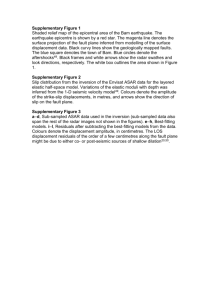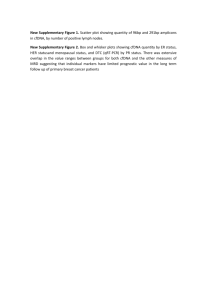Electronic supplementary materials Supplementary materials and
advertisement
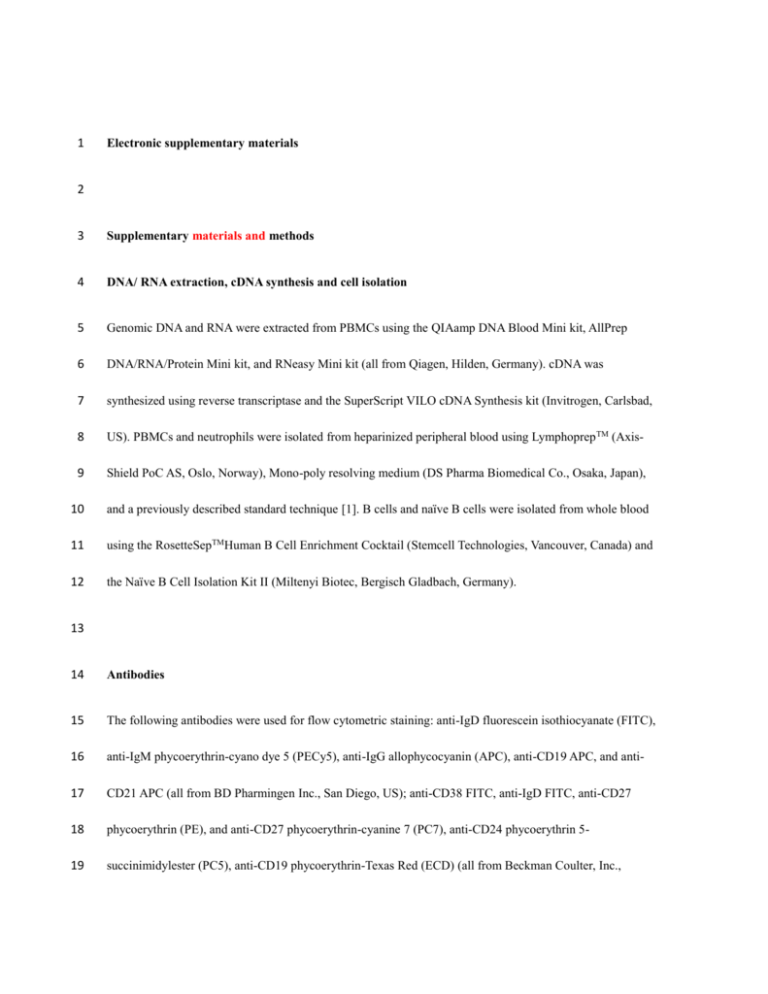
1 Electronic supplementary materials 2 3 Supplementary materials and methods 4 DNA/ RNA extraction, cDNA synthesis and cell isolation 5 Genomic DNA and RNA were extracted from PBMCs using the QIAamp DNA Blood Mini kit, AllPrep 6 DNA/RNA/Protein Mini kit, and RNeasy Mini kit (all from Qiagen, Hilden, Germany). cDNA was 7 synthesized using reverse transcriptase and the SuperScript VILO cDNA Synthesis kit (Invitrogen, Carlsbad, 8 US). PBMCs and neutrophils were isolated from heparinized peripheral blood using Lymphoprep TM (Axis- 9 Shield PoC AS, Oslo, Norway), Mono-poly resolving medium (DS Pharma Biomedical Co., Osaka, Japan), 10 and a previously described standard technique [1]. B cells and naïve B cells were isolated from whole blood 11 using the RosetteSepTMHuman B Cell Enrichment Cocktail (Stemcell Technologies, Vancouver, Canada) and 12 the Naïve B Cell Isolation Kit II (Miltenyi Biotec, Bergisch Gladbach, Germany). 13 14 Antibodies 15 The following antibodies were used for flow cytometric staining: anti-IgD fluorescein isothiocyanate (FITC), 16 anti-IgM phycoerythrin-cyano dye 5 (PECy5), anti-IgG allophycocyanin (APC), anti-CD19 APC, and anti- 17 CD21 APC (all from BD Pharmingen Inc., San Diego, US); anti-CD38 FITC, anti-IgD FITC, anti-CD27 18 phycoerythrin (PE), and anti-CD27 phycoerythrin-cyanine 7 (PC7), anti-CD24 phycoerythrin 5- 19 succinimidylester (PC5), anti-CD19 phycoerythrin-Texas Red (ECD) (all from Beckman Coulter, Inc., 20 Indianapolis, US); anti-IgA PE, anti-CD19 APC, anti-CD19 VioBlue, anti-CD19 PacificBlue, anti-CD20 21 VioGreen, and anti-CD24 PE (all from Miltenyi Biotec, Bergisch Gladbach, Germany); and anti-CD14 Alexa 22 Fluor 700 (BioLegend, San Diego, US). Expression of BTK was determined in monocytes stained with an 23 anti-BTK monoclonal antibody [48-2H] and control IgG1 (Dako Japan Inc., Tokyo, Japan) as previously 24 reported [2]. Expression of tumor necrosis factor receptor superfamily, member 13B (TNFRSF13B) was 25 determined in memory B cells by using a rat anti-TNFRSF13B monoclonal antibody [1A1] (Abcam, 26 Cambridge, UK) and control IgG2a (eBioscience, San Diego, US). 27 28 Exome and sequencing analysis 29 Variant calling was performed using the Genome Analysis Toolkit (GATK) [3] In the validation study, 30 genomic DNA from the patient and his parents was amplified by means of polymerase chain reaction (PCR) 31 and PCR products were sequenced using the BigDye Terminator (Applied Biosystems, Foster City, US). 32 33 Sequencing analysis of BTK and TNFRSF13B 34 In the validation study, genomic DNA was amplified by PCR using High Fidelity PCR Master (Roche 35 Applied Science, Indianapolis, US) or PrimeSTAR GXL DNA Polymerase (Takara Bio Inc., Shiga, Japan). 36 PCR was performed for 30 cycles at an annealing temperature of 60 °C for 15 to 30 seconds. PCR products 37 were sequenced with the forward primer 5’-ACAGCTTCTTTTTCGTTGTTTC-3’ and the reverse primer 5’- 38 GAAAGAGGAGAGCTTCTGATTTTG-3’ for exon 11 of BTK, and with the forward primer 5’- 39 GTGATTGCCCTTAGCTCCTG-3’ and the reverse primer 5’-AACCCAAGGTCACAAGCTTC-3’ for exon 5 40 of TNFRSF13B. 41 42 In vitro class switch recombination 43 Naïve B cells (CD19+CD27- cells) were purified to a purity of >90% by using the Naïve B Cell Isolation Kit II 44 (Miltenyi Biotec, Bergisch Gladbach, Germany). A total of 1 106 cells/ml B cells or naïve B cells were 45 incubated in RPMI 1640 supplemented with 10% fetal bovine serum in 96-well plates at 37°C in 5% CO2 with 46 or without LEAFPurified anti-CD40 [G28.5] (1 µg/ml; BioLegend, San Diego, US) and human IL-21 (100 47 ng/ml; Miltenyi Biotec, Bergisch Gladbach, Germany). The culture supernatants were collected on day 12 and 48 the level of immunoglobulin was measured by enzyme-linked immunosorbent assay (ELISA) [4]. 49 50 Measurement of T cell receptor excision circles and kappa-deleting recombination excision circles levels 51 The levels of TRECs and KRECs were measured in whole blood by real-time PCR as described previously 52 [5]. RNase P was used as an internal control. 53 54 Measurement of reactive oxygen species production by neutrophils 55 ROS production by neutrophils was quantified using standard chemiluminescence using phorbol 12-myristate 56 13-acetate (PMA) and luminol (Sigma-Aldrich) as previously described [1]. In brief, neutrophils (1 × 106 57 cells) were suspended in 0.5 ml PBS containing luminol (10 μM) preheated to 37 °C. After a baseline 58 measurement was obtained, cells were stimulated with PMA (100 ng/ml), and luminescence signals were 59 monitored throughout the reaction. 60 61 Supplementary results 62 Supplementary Table 1. Parameter Value Normal range White blood cells (/μL) 12,800 6,600–13,600 CD3+ T lymphocytes (% of lymphocytes) 43.0 56–87 CD16+CD56+ NK cells (% of lymphocytes) 32.1 1–64 CD19+ B lymphocytes (% of lymphocytes) 14.2 11.1–45.4 IgG (mg/dl) 1,335 792 376.5 IgG1 (mg/dl) 963 234.0–830.6 IgG2 (mg/dl) 337 50.8–224.0 IgG3 (mg/dl) 151 18.7–95.4 IgG4 (mg/dl) <3.0 0.3–16.5 IgA (mg/dl) <4.0 56.0 21.7 IgM (mg/dl) 49 83.8 37.2 anti-measles-specific IgG antibody (EIA) 4.1 2.0 anti-rubella-specific IgG antibody (EIA) 14.0 2.0 TRECs (copies/μg DNA) 2.0 × 105 KRECs / intronRSS-KDE (copies/μg DNA) 4.6 × 104 / 3.8 × 104 63 64 Supplementary Table legend 65 Table I. Laboratory data of patient at 10 months of age 66 Age-matched normal range was taken from previous reports [6-9]. EIA, Enzyme immunoassay; TRECs, T cell 67 receptor excision circles; KRECs, kappa-deleting recombination excision circles; RSS-KDE, Recombination 68 signal sequence-kappa deleting element. 69 70 Supplementary figure legends 71 Supplementary Fig 1. Patient (1-year-old) peripheral B cell subpopulation. 72 Flow cytometric analyses of patient lymphocyte CD21, CD24, CD38, IgD, and CD27 expression. 73 74 Supplementary Fig 2. Filtering approach for detected mutations by whole-exome sequencing. 75 Mutations registered in dbSNP database version137 were excluded, and coding region, splice site, and non- 76 synonymous mutations were selected. The number of these variants after each filtering step is shown. 77 Genotype and type of amino acid change are shown for selected mutations. 78 79 Supplementary Fig 3. Genetic analysis of TNFRSF13B. 80 a, Sanger sequencing of TNFRSF13B exon 5 in the patient and his parents. b, Flow cytometric analysis of 81 TNFRSF13B expression. Solid line, healthy donor; dotted line, mother; small dotted line patient; gray, isotype 82 control. 83 84 Supplementary Fig 4. B cell signaling and in vitro immunoglobulin production. 85 a. Flow cytometric analyses of PLCγ2 phosphorylation in CD19normal (solid line) or CD19low (dotted line) 86 stimulated with anti-IgM antibody. gray, unstimulated cells. b. IgG and IgA production from naïve B (healthy 87 donors) or B cells (patient) incubated with anti-CD40 antibody and IL-21. Control values represent four 88 independent experiments (mean SE). Open bars, unstimulated cells; solid bars, stimulated cells. 89 90 Supplementary Fig 5. Neutrophil ROS production. 91 Kinetics of H2O2 production in neutrophils from healthy donors (open symbols) and patient (closed symbols). 92 Arrows indicate time points of stimulation with phorbol 12-myristate 13-acetate (PMA), N-formyl-Met-Leu- 93 Phe (fMLP), and LPS plus fMLP 94 95 Supplementary references 96 1. 97 regulates the production of reactive oxygen species and stimulation-induced apoptosis in human neutrophils. 98 Nature immunology. 2012;13(4):369-78. 99 2. Honda F, Kano H, Kanegane H, Nonoyama S, Kim ES, Lee SK, et al. The kinase Btk negatively Kanegane H, Futatani T, Wang Y, Nomura K, Shinozaki K, Matsukura H, et al. Clinical and mutational 100 characteristics of X-linked agammaglobulinemia and its carrier identified by flow cytometric assessment 101 combined with genetic analysis. The Journal of allergy and clinical immunology. 2001;108(6):1012-20. 102 3. 103 Toolkit: A MapReduce framework for analyzing next-generation DNA sequencing data. Genome research. 104 2010;20(9):1297-303. 105 4. 106 Production in Neonatal Naive B Cells by Memory CD4+ T Cell Subset Expressing Homing Receptor L-Selectin. 107 Journal of immunology. 1994;152:4417-24. 108 5. 109 reveals homeostatic proliferation and extensive antigen-induced B cell expansion. The Journal of experimental 110 medicine. 2007;204(3):645-55. McKenna A, Hanna M, Banks E, Sivachenko A, Cibulskis K, Kernytsky A, et al. The Genome Analysis Tsuji T, Nibu R, Iwai K, Kanegane H, Yachie A, Seki H, et al. Efficient Induction of Immunoglobulin van Zelm MC, Szczepanski T, van der Burg M, van Dongen JJ. Replication history of B lymphocytes 111 6. 112 characterization and reference values of the pediatric T- and B-cell compartments. Clinical immunology. 113 2009;133(1):95-107. 114 7. 115 embryonic stage and childhood. Nihon Shonika Gakkai Zasshi. 1969;73(4):564-76. 116 8. 117 values for the peripheral T cell compartment. Scandinavian journal of immunology. 2012;75(4):436-44. 118 9. 119 childhood determined by a sensitive ELISA. Acta Paediatr Jpn. 1993;35(2):113-7. 120 van Gent R, van Tilburg CM, Nibbelke EE, Otto SA, Gaiser JF, Janssens-Korpela PL, et al. Refined Hirohisa F. Study on dynamics of immunoglobulin in children. 1. Immunoglobulin production in the Schatorje EJ, Gemen EF, Driessen GJ, Leuvenink J, van Hout RW, de Vries E. Paediatric reference Hayashibara H, Tamnimoto K, Nagata I, Harada Y, Shiraki K. Normal levels of IgG subclass in





